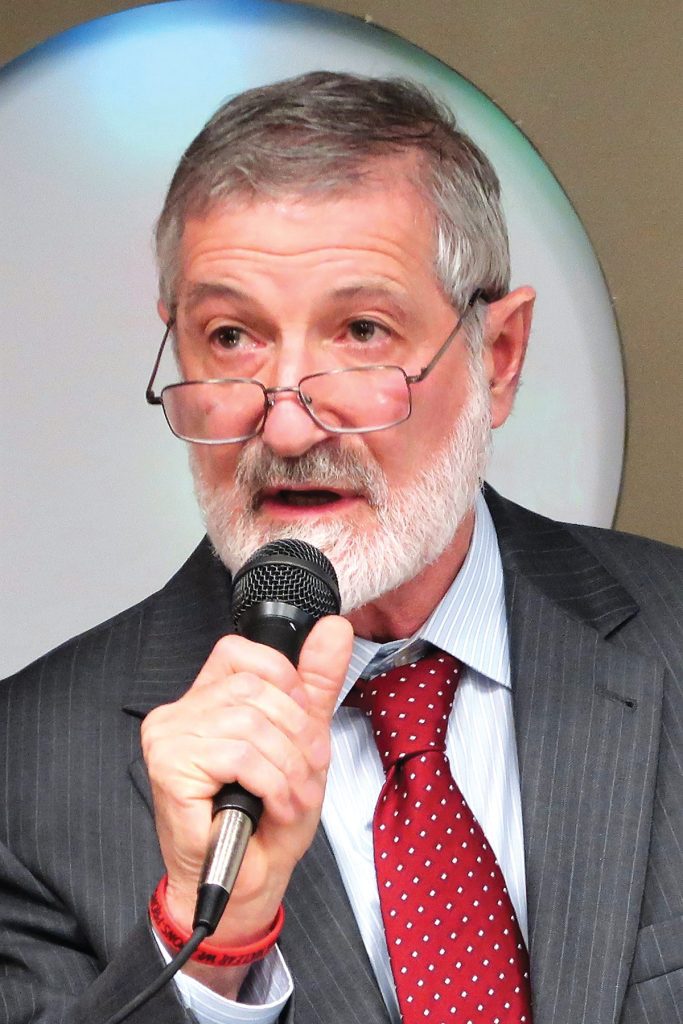Physician Says Momentum May Be Building to Ban Nuclear Weapons
Seizing the Moment
Dr. Ira Helfand notes that, since Russia became the second nation to produce nuclear weapons in the late 1940s, the threat of a global nuclear conflict has always been real.
To most, though, it has never really seemed real, except for the duration of the Cold War, which officially ended more than 30 years ago, and especially that two-week crack in time in 1962 that came to be known as the Cuban Missile Crisis, said Helfand, noting that for many, that event is only something to be read about, not something they lived through.

But the events in Ukraine are changing this narrative, and in a profound — and urgent — way, said Helfand, a retired emergency room physician at Mercy Medical Center and co-chair of the Physicians for Social Responsibility’s Nuclear Weapons Abolition Committee, a name that clearly speaks to its mission.
He told HCN that recent events — not just those in Ukraine but also those in North Korea, as well — have made the threat of nuclear war as real as ever. And while this is certainly a scary time because of these threats, it might also be considered a time of opportunity when it comes to the Nuclear Weapons Abolition Committee and its stated mission.
“If there is to be any good that comes out of this terrible disaster in Ukraine, perhaps it will be an understanding of the need around the world to eliminate nuclear weapons,” he said. “Which will lead to effective political action to achieve that.”
In recent months, Helfand, who has, over the years, spoken to groups ranging from local Rotary clubs to special sessions of the United Nations General Assembly on the subject of preventing nuclear war, has been ramping up such efforts — through speaking engagements, op-ed pieces, and interviews with media out like this one — and using current events to bring more attention to a 75-year-old issue.
The initiative is called the ‘Back from the Brink Campaign,’ which is based on the nuclear-freeze campaign of the 1980s, which brought about an end to the Cold War arms race, he said. Except this time, the goal is to get rid of the weapons altogether.
Those behind the effort are “organizing around a simple platform, a simple statement of what U.S. nuclear policy ought to be — a key part of which is a call for the United States to begin now to negotiate with the other eight nuclear-armed countries for a verifiable, enforceable, mutual timetable to eliminate nuclear weapons,” he said. “This is not unilateral disarmament, it’s a call for the United States to lead the negotiations to achieve universal disarmament.”
Organizers have brought resolutions embodying this platform to cities and towns, civic organizations, and faith organizations across the country, he went on, adding that more than 60 municipalities, including Springfield, Worcester, Boston, and others in Massachusetts have signed the statement, as well as several state legislatures.
If the United States and Russia go to war today, it’s not going to be one relatively small bomb used on one or two cities, as was the case in 1945; it’s going to be many bombs used against many cities, and these bombs will be 10 to 50 times more powerful than the one that destroyed Hiroshima.”
The goal is to gain a national consensus on the matter, said Helfand, adding that he senses momentum in the ongoing efforts to ban nuclear weapons and the potential for much more.
“The current war in Ukraine is putting this issue before people again in a way that will lead to a good outcome,” he noted. “This issue is back where it ought to have been all this time — on the table and on the public agenda. We’ve been trying to use this occasion to educate people about the danger.”
For this issue, HCN talked at length with Helfand about Back from the Brink and ongoing efforts to prevent a nuclear war by banning such weapons. He expressed the hope that current events may just provide inspiration to bring change on a truly global scale.
Understanding the Consequences
Helfand, who has published studies on the medical consequences of nuclear war in the New England Journal of Medicine, the British Medical Journal, the World Medical Journal, and other publications, said one challenge to banning nuclear weapons is a lack of clear understanding among many people about just what a nuclear conflict would be like.
Back in the ’80s, everyone understood that nuclear war was a real threat; people were concerned about it, and they took political action to try to end the Cold War, work that was ultimately successful. But when the Cold War ended, everyone assumed that the danger had passed, and they stopped paying attention to the issue.”
Indeed, he told HCN that many still think in terms of 1945 and the weapons used then when they contemplate nuclear war.
So, he isn’t at all shy about painting what he said is a much more accurate picture, and he did so for HCN.
“If the United States and Russia go to war today, it’s not going to be one relatively small bomb used on one or two cities, as was the case in 1945; it’s going to be many bombs used against many cities, and these bombs will be 10 to 50 times more powerful than the one that destroyed Hiroshima,” he said. “If that were happen, within a thousandth of a second, a fireball would form reaching out two miles in every direction, four miles across. Within this entire area, everything would be vaporized — buildings, trees, people … the upper level of the Earth itself would disappear.
“To a distance of four miles in every direction, the explosion would generate winds of 600 miles per hour,” he went on. “Mechanical forces of that nature destroy anything that human beings can build. To a distance of six miles in every direction, the heat would be so great that automobiles would melt, and to a distance of 16 miles in every direction, the heat would still be so intense that everything flammable would burn — paper, cloth, wood, gasoline, heating oil, plastic … it would all ignite. There would be hundreds of thousands of fires, which over the next half hour, would coalesce into a giant firestorm 32 miles across, covering more than 800 square miles. Within this entire area, the temperature would rise to 1,400 degrees Fahrenheit, all the oxygen would be consumed, and every living thing would die.
“In the case of Boston, we’re talking about 3 million to 5 million people, depending on the time of day,” he continued. “In the case of New York, 12 million to 15 million people, and if we have a major war with Russia, that’s what’s going to happen to every major city in both countries. In addition, the entire economic infrastructure of the country would be destroyed; we would see 200 million to 400 million dead in the first afternoon, but those who survived would be living in an environment with no electric grid, no healthcare system, no internet, no food-distribution system — none of the things we rely on to survive.”
Beyond all of this, there would be enormous effects on climate, he said, noting that perhaps 150 million tons of soot would be deposited into the atmosphere, blocking out the sun, and dropping temperatures across the planet an average of 18 degrees Fahrenheit “which is much colder than the coldest moment of the last ice age.”
Preventing such a calamity has long been the goal of Physicians for Social Responsibility, a national organization of physicians, other health professionals, and others who are concerned about the medical consequences of nuclear war. Started in 1978, the organization has a stated mission to educate the public and decision makers about those medical consequences, “in the hope that a better-educated public and a better-educated body of decision-makers would make smarter decisions about nuclear weapons than they have been making, unfortunately,” said Helfand.
The group is part of an organization called the International Federation for the Prevention of Nuclear War (IFPNW), which has affiliates in 55 countries. In 1997, the IFPNW started a global campaign to abolish nuclear weapons, which, in collaboration with some state governments, led to the adoption at the United Nations in 2017 of the Treaty on the Prohibition of Nuclear Weapons, which entered into force in January 2021.
Marshalling Forces
In recent months, the IFPNW has been increasingly active in pushing toward its goal of bringing an end to nuclear weapons, and as noted earlier, it is using the crush of current events to state its case and bring the issue to the fore — or back to the fore.
“For the past 30 years, since the end of the Cold War, the biggest obstacle we’ve faced in doing our work has been the fact that people had thought the nuclear danger had gone away,” Helfand explained. “Back in the ’80s, everyone understood that nuclear war was a real threat; people were concerned about it, and they took political action to try to end the Cold War, work that was ultimately successful. But when the Cold War ended, everyone assumed that the danger had passed, and they stopped paying attention to the issue.
“That has changed dramatically in the past few months since Putin invaded Ukraine and issued a series of very explicit nuclear threats,” he went on. “Which, by the way, were responded to by NATO with equally inappropriate nuclear threats.”
Elaborating, Helfand said the current events in Ukraine bring new meaning to sentiments expressed in a quote he attributed to Robert McNamara, U.S. Defense secretary during the Vietnam War.
“He said, famously, ‘we lucked out — it was only luck that prevented nuclear war,’” noted Helfand, adding that have been countless times over the past 77 years when the world almost experienced nuclear war, but didn’t, for reasons that have little to do with the conventional wisdom regarding these weapons.
“There has been this myth, with enormous power attached to it, that nuclear weapons are so terrible that they will deter their own use — no one will ever make the mistake of using them,” he explained. “We know that over the decades, that has not been true.”
Elaborating, he said that over the years, the United States has threatened to use nuclear weapons repeatedly, in many circumstances involving countries that did not have nuclear weapons, and Russia has as well. And beyond these threats, there has always been the threat of something happening by accident.
“There have been many, many occasions when we have come within minutes of nuclear war because one side or the other received a false alert and believed they were under attack by the other side,” he explained. “On many of these occasions, we came within minutes of all-out nuclear war because of a computer glitch or some similar technical mistake.”
Given the immense amount of tension in the world now, another glitch of this kind may well lead to calamity, he said, bringing even more urgency to the matter of banning such weapons.
That course is the only logical choice for the planet, said Helfand, adding that the alternative, staying the current course, is not sound thinking.
“Our current policy — maintaining these enormous arsenals with the expectation that they will never be used — is nothing more than the hope for continued good luck,” he told HCN. “And this is a fairly insane basis for national security policy. We need to plan for the future based on reality, not hopes and prayers.
Looming Questions
“Those who build nuclear weapons will argue that we need to have more of them — that argument will gain some traction,” he said. “They’ll say ‘the Russians are really bad — we need to be even stronger, as if the 6,000 nuclear weapons we already have are not enough to do what anyone could possibly want to do with them.
Returning to that question about whether he’s sensing any momentum on the IPPNW’s broad mission to prevent nuclear war by eliminating such weapons, Helfand said there are a few narratives that could flow from the present situation.
“But there will be another narrative as well,” he went on. “As happened after the Cuban Missile Crisis, when both Kennedy and Khrushchev recoiled in horror from what they had almost done, people around the world are going to look at this moment and say, ‘this was a world-wide near-death experience; we cannot keep rolling the dice and hoping that we’re going to be luck every time — we have to get rid of the weapons.’”
That’s why he looks on this very scary time in the history of the world as something else — an opportunity.




